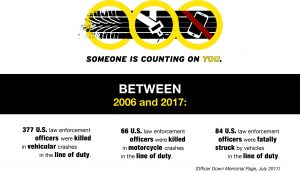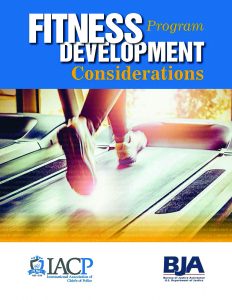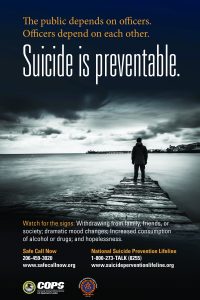Law enforcement working conditions and exposure to stress and trauma places officers at a greater risk for injuries and illnesses than the general public. The U.S. Bureau of Labor Statistics found that law enforcement patrol officers in the United States average 30,990 nonfatal injuries involving days away from work each year.1 These injuries and missed workdays result in increased costs for workers’ compensation, overtime to backfill positions, and medical treatment expenses. Beyond the agency impact, physical injuries and mental health challenges have a substantial, often traumatic, personal impact on the officers who experience them.
The International Association of Chiefs of Police (IACP) remains committed to providing law enforcement professionals with the resources they need to remain healthy and safe every shift, every day. Over the years, IACP has done considerable work to advance the physical and mental health of law enforcement officers, including producing the Reducing Officer Injuries Final Report, released in 2009, in partnership with the Bureau of Justice Assistance (BJA), Office of Justice Assistance, U.S. Department of Justice. This seminal study provided information on the most common types of officer injuries, risk factors that influence officer injuries, and the organizational impact that officer injuries have on law enforcement agency staff and budgets. The study also revealed the need for greater training on high-risk activities and procedures, improved access to physical fitness and mental health resources, and more consistent tracking of officer injuries.2
Building on these identified needs, IACP has released a series of new resources to help law enforcement agencies develop and enhance officer safety and wellness programming.
Fitness Program Guide
Research shows that police officers are more likely to be obese and more likely to have metabolic syndromes, including high blood pressure, high blood sugar, and abnormal cholesterol.3 They are also at increased risk for heart attacks and sleep disorders.4 These issues pose a serious risk to officers’ personal health and well-being and can affect their ability to do their jobs safely and effectively.
In partnership with the BJA, IACP released the Fitness Program Development Considerations Guide in January 2018 to help law enforcement agencies make fitness a priority from recruitment through retirement. This guide lays out the steps required to start or enhance a fitness program and to overcome some of the common hurdles.
Program design and standards: Because officer fitness is, in many ways, a personal issue as well as a professional one, implementing a fitness program is not as simple as opening the doors to a gym facility. Rather, a successful program requires a mind-set and organizational culture that values fitness and wellness. Agencies need to design a program that will work for their specific departments, taking into consideration demographics, internal culture, and individual employee needs. Program design considerations include determining how the program will be staffed, as well as where, when, and how officers will perform fitness activities.
Legal and liability issues: When starting a fitness program, there are a variety of liability and legal concerns to address. Leadership should engage the agency’s legal counsel to make sure that all fitness policies and protocols meet federal, state, and local workplace guidelines and properly address liability and assumption of risk.
Internal and external stakeholder involvement: Involving internal and external stakeholders from the beginning is important when planning a fitness program. Partners can provide subject matter expertise, identify potential pitfalls, assist with accessing resources for the program, and support greater buy-in for the program. Beyond the planning stages, these partners can serve as an advisory group to sustain and evaluate the program.
Employee engagement plans: Because fitness programs may require a shift in agency culture and, in some cases, the personal mind-sets of officers, special care should be taken to make the program inviting and engaging for all. Ease of access is a key indicator of success with fitness programs. Programs should offer a diverse range of fitness activities that can accommodate workers in all shifts. Exercise can often feel like an obligation for officers, especially through a workplace fitness program; therefore, fitness programs should aim to incorporate activities that are fun and
engaging—friendly office competitions, incentives for goals met, or engaging family members in workouts.
Data tracking and evaluation: Data maintenance and collection are very important for measuring the value of a fitness program. Data can show what areas of a department’s fitness program are working and what areas may need improving, as well as identify training needs based on data trends. If the department maintains good data over the progress of a program, the importance of continuing the program can be easily conveyed to local budget managers, risk managers, funders, and agency personnel.
Changing the culture of a department to embrace physical wellness and integrate it into the officers’ daily work lives is not an easy or short process, but it is a crucial element of ensuring a healthier and safer department. Fitness and wellness are important aspects of every officer’s job. A properly maintained program will help keep personnel healthier, happier, and less prone to injuries.
Traffic Safety Dashboard Decal and Postcard

Through the Reducing Officer Injuries study, as well as other studies on officer and traffic safety, several simple, consistent, evidence-based recommendations arose as ways to reduce officer injuries and save lives. To keep these recommendations front and center in officers’ minds, IACP and BJA developed a postcard and dashboard decal with these essential tips:
- Drive safely—When researching officer traffic fatalities, several commonalities were found among these tragedies. Fatal crashes most commonly occurred during the nighttime hours of 8:00 p.m. to 4:49 a.m.5 Excessive speed is another common trait of officer traffic fatalities. Knowing these risks can help agencies tailor their training to help officers stay safe on the road.
- Buckle up—Law enforcement officers regularly enforce seat belt laws to promote traffic safety. It is equally important for officers to wear seat belts themselves. The National Highway Traffic Safety Administration found that the use of seat belts reduces serious crash-related injuries by approximately half.6 Mandatory seat belt use can be encouraged by training officers and supervisors and should be backed up by agency policy.
- Pay attention and stay alert—The availability and accessibility of in-vehicle technologies are quickly evolving. While these tools often increase efficiency, they can also increase distracted driving. Officer and supervisor training should reinforce the message that in-car technology should be used only when the vehicle is stationary.
Officer Suicide Prevention Poster
Law enforcement agencies are shaken to the core by the death of one of their own, and the response is even more complex when that death comes at the officer’s own hand. IACP and the Office of Community Oriented Policing Services (COPS Office) have been leaders in bringing the oft-unspoken concerns of officer mental health care and suicide prevention into focus with law enforcement leaders, beginning with a national symposium on these issues in July 2013. Building on the recommendations of that symposium, IACP and the COPS Office began developing a new series of tools to help officers, agency leaders, and family members learn to identify signs of mental health crises and to encourage officers to seek treatment.
In October 2016, IACP and the COPS Office released the Officer Suicide Prevention and Awareness poster to alert officers about mental health risk indicators and to provide resources for help. The poster includes a general awareness message along with potential warning signs and two hotlines for support. Posters can be hung in break rooms, locker rooms, and roll call and training rooms. The poster reminds law enforcement officers that suicide is preventable and calls on officers to support each other when warning signs occur.
Officer safety is a top concern for IACP and for police executives around the world. Every chief, supervisor, and family member wants officers to return home healthy and safe each day. By using tools like those outlined above to establish programs, policies, and training that promote evidence-based safety, health, and wellness concepts, agencies can make a cultural shift in how these topics affect officers at all stages of their careers. ♦
Notes:
1U.S. Department of Labor Statistics, “Injuries, Illnesses, and Fatalities: Police Officers Fact Sheet,” August 2, 2016.
2IACP, Reducing Officer Injuries Final Report (Washington, DC: Bureau of Justice Assistance, Office of Justice Programs, U.S. Department of Justice, 2009).
3Mark St. Hilaire, “Bcops Study Indicates Police Work May Have Adverse Health Effects,” Law Enforcement Today, July 18, 2012.
4Joseph B. Kuhns, Edward R. Maguire, and Nancy R. Leach, Health, Safety, and Wellness Program Case Studies in Law Enforcement (Washington, DC: Office of Community Oriented Policing Services, 2015).
5Eun Young Noh, Characteristics of Law Enforcement Officers’ Fatalities in Motor Vehicle Crashes (Washington, DC: U.S. Department of Transportation, National Highway Traffic Safety Administration, 2011).
6National Highway Traffic Safety Administration, “Seat Belts,” 2016.
Please cite as
Jennifer Styles, “Improving Officer Safety and Wellness Every Shift, Every Day,” IACP Working For You, The Police Chief (March 2018): 78–80.




